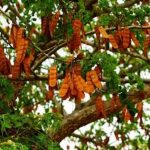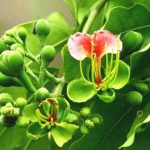TREE LIFE
NOVEMBER 1995.
MASHONALAND CALENDAR
Tuesday 7th November. Botanic Garden walk at 4.45 for 5 p.m. we will meet Tom in the public car park of the Gardens and continue where we left off last month. There will be a guard for the cars.
Saturday 18th November. At 2.00 p.m. a walk in the Warren Hills to see various terrestrial orchids with Werner Fibeck, who expects to see some 10 species. Park on the side of the Golden Quarry road adjacent to the Kubatana Stone Sculpture works, that is, close to the intersection with the Bulawayo road. The cars will be guarded.
Sunday 19th November. Such was the enthusiasm for our last visit to Marussino farm in the Trelawney district that a return visit was considered a ‘must’ especially as many members were unable to attend. The rock paintings at this venue are reported to be unusual and in a good state of preservation.
Saturday 25th November. Mark’s walk is to a special spot between Marimba Angling Club and the bird sanctuary at Lake Chivero. We will leave Larvon Bird Garden promptly at 2.30 p.m. and plan to study the plants which have come up on the dry lakebed as well as looking at the trees along the shoreline.
Tuesday 5th December. Botanic Garden walk
Sunday 10th December. Something different is being planned for our Christmas get together, close to Harare at a game park.
MATABELELAND CALENDAR
Sunday 5th November. Due to the very dry conditions prevailing in Matabeleland, the planned visit to June Davies’ farm is postponed to a later date when the rains have fallen and the vegetation improves. Instead, a video will be shown at Girls’ College at 10 a.m. The College will provide tea.
Monday 13th November. At 7.45 for 8 we will show the final episode of The Private Life of Plants entitled ‘Surviving’.
Friday 1st December to Sunday 3rd December. At East Kana Estates, a safari operation on the Falls road (230km on tar and 10km on dirt). Wonderful botanics and accommodation for 20. First come first served. Phone Ian or Margaret McCausland in the evenings. Open to Bulawayo and Harare botanical enthusiasts.
Monday 1st January 1996. Our usual social – details later.
Appearing with the rains will be a wonderful assortment of fungi and Cathy Sharp has requested that we do some collecting for her. For the time being Cathy asks that we collect only the tree-rotting fungi, i.e. the bracket fungi.
After picking, the specimens should be sprayed with an insecticide (the usual sort used against mosquitoes and flies), and placed in a paper bag with the following information –
• Your name and address.
• Date collected.
• Soil type, i.e. sand, clay, etc.
• Identity of the host tree if possible.
• Description of the surrounding area.
• Location found – as accurately as possible (QDS).
• The local name with dialect if known.
• Anything else that you feel would be of interest.
The packets may be left at Savannah Wildlife, 88 Baker Avenue, and they will be delivered to Cathy at Mvuma. As the bracket fungi are light you may prefer to post them. Just wrap in some newspaper and pop them into an envelope (don’t forget the data).
We have commissioned very attractive badges and key rings with a Msasa motif in natural colours – lovely Christmas gifts! We have them for sale at our outings at $2 each.
M’torcha 17/9/95
Perhaps it would be a good idea to re-read the excellent article in Tree Life of March ’95 by MSJ/BM where they vividly describe this magical place. However, seven months on and at the start of the hot dry season the vegetation was certainly different, only the brooding mass of granite remaining unchanged.
The grey leafless woodland highlighted a kaleidoscope of colours; the sheer rock faces a mural of red, yellow and orange lichens and grey patches of sedges. High above in the stately Msasas, cicadas hidden by new foliage heralded the summer with their shrill whine. As luck was on our side the magical sight of flowering paper-barks Albizia tanganyicensis lit up the hillside with patches of yellow, the long stamens giving the impression of shaving brush like flowers.
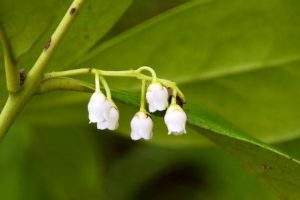
Euclea racemosa, Photo: Bart Wursten. Source: Flora of Zimbabwe
Along the route up to the flat col, Kurt’s new aluminium tree labels glinted in the sun, flicking names such as Pseudolachnostylis maprouneifolia and Euclea racemosa, the former in new leaf and tiny white 5-petalled flowers while the latter had shiny green wavy leaves. Also seen were some Euphorbia matabelensis distinctly 3-forked; a grove of Ximenia americana and Garcinia buchananii, reluctantly producing its yellow sap from a leaf bent in half.
A civet’s midden nearby brought memories of Dickie Graves’ notes about civetries and probing (with a stick) produced strings of well-gnawed fruit (Parinari curatellifolia?), which by the number we found must have formed the main part of the civet’s meal. The dogs also found the midden interesting and rolled in it. The pool on the road, now smelling rather dubious, did not concern our four canine companions who plunged into the murky water – a good idea as the pool’s odour was better than that of the wiffy civetry. Stewart’s binoculars picked up an almost inaccessible cave with a bushman painting depicting two bulbous shapes (porcupines?), the entrance guarded by a pair of gnarled green Commiphora marlothii – a really good day for paper barks. Some distance away Richard Dennison noted a Klaas’s’ Cuckoo and a Wattle-eyed Flycatcher.
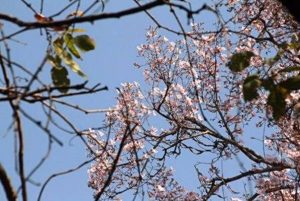
Stereospermum kunthianum. Photo: Mark Hyde. Source: Flora of Zimbabwe
Below the pool a particularly special sight, that of the flowering Stereospermum kunthianum – I’ve never seen so many. A few warm gusts of wind gently shook the pale haze of flower, dropping a few wilted blooms onto the deep leaf mould below. When examined these flowers resembled the ubiquitous Jacaranda mimosifolia. Not really surprising as they are both Bignoniaceae, except that the delicate pink petals and red-striped throat give the common name and that they are larger with the stamens and scientific parts within the deep corolla. The coarse leaves resemble Kigelia and smooth dark grey bark with lighter patches of bark peel adds up to a really attractive tree.
Bob, Richard and Jean ventured through another large open cave hoping to reach the summit and the pool we swam in last January. After hauling themselves up a steep path they found a wall blocking their path, which meant, for them, the long haul back to the cars and up the other heavy route. Within this cave lurks a curiously bent Trichilia emetica following the overhanging rock. Carefully hidden in one of the bends we noticed a thermometer reading the cooler ambient temperature in the 80’s – could only be a Fahrenheit scale. Heteropyxis dehniae, although not at their best thing between fruiting and first leaves, were clustered around an overhanging boulder which housed Kurt’s neat stone cabin overlooking the dam and surrounding lands. These trees with peeling bark and shiny leaves would be attractive garden subjects. Kenneth Haxen having endured arboreal indigestion for some time, found to his great delight, a scorpion’s lair under some exfoliating rock on the col. A Rock Scorpion, with a miserable sized sting unimpressed by humans tearing up its roof headed for the nearest patch of shade – under Cheryl’s foot. Amazing how much fear these tiny creatures cause in the human race. Needless to say, the scorpion shortly found itself secured in a plastic tub, making a bid for freedom when the tub fell over and Hadogenes sp. coiled up its tail and scrambled for refuge under the Haxen’s lunch table. The ensuing panic left to your imagination!
The moist soils and the deep leaf mould around the base of the kopjie must be the ideal ecosystem to judge by the sheer size of the trees around. From groves of densely grouped Trichilia emetica, one of which Phil and I linked hands to gauge the bole size – in this case 2megs*, to beautifully shaped Ficus cordata following the rock face, smooth grey trunk and fresh green spear shaped leaves with a slender petiole. A grove of amazing Bequaertiodendron magalismontanum with trunks fluted to the extreme, clustered around a spot where a massive curved rock face looked as if some giant feet had squeezed their way up the rock! Some of the other superbly sized trees were Bridelia micrantha, Kirkia acuminata with its distinctive fruits clustered on the terminal branches, and some others. Terminalia sericea, Brachystegia boehmii, Uapaca nitida and Uapaca kirkiana, Ficus thonningii, Ficus glumosa with pink and yellow patches on the trunk. Tarenna neurophylla with limp leaves, Pittosporum viridiflorum with lenticelled bark, the unusual shaggy barked Pavetta eylesii, Mundulea sericea, Sterculia quinqueloba and we won’t forget the waxy leaved Maytenus undata.
Another wonderful day filled with unexpected sights. Once again our most grateful thanks to the Braunstein and MacLachlan families and please may we come back for another visit?
• A measurement courtesy of Meg Coates Palgrave, very useful for a quick on-site measurement of tree bole diameter.
-A. MacNaughtan
SNIPPETS
In Tree Life No. 187 there was a note on the discovery of living trees of a fossil genus in Australia, and more information on the discovery has recently been received, which has served to correct errors contained in a short news story published in The Daily Telegraph. It was this new item that provided the basic information for the note in Tree Life No. 187.
The new species has been named Wollemia nobilis and it belongs to the coniferous family Araucariaceae, which contains two other genera, Agathis (the kauri pines) and Araucaria (the monkey puzzles). Wollemia nobilis has been described as the tree find of the second half of the 20th Century. The genus was known only from fossil records before a grove of around 40 living specimens was found in late 1994 in the Wollemi National Park in the Blue Mountains of New South Wales, about 140km from Sydney. The Daily Telegraph news story managed to misspell the common name of the tree as Weollemi pine.
Wollemia nobilis has a light green foliage and the leaves have a complex and unusual structure. It is monoecious (both sexes on the same plant), with bright green female cones and brown cylindrical male cones at the branch tips. The bark has an unusual knobbly, cork-like appearance. Mature trees attain 35 m or more (one fallen stem measures 38 m). The pollen matches that of trees growing during the cretaceous (130 million to 65 million years ago). The species fossil record is, in fact, well established, showing it to have been fairly common in the rainforest up to about 30 million years ago, and most recently observed in 2 million year old sediments in the Bass Strait, which separates Tasmania from the Australian mainland. The fossil record shows that Wollemia nobilis has survived a remarkable 90 million years in Australia. It would seem then, that it finally separated (cf. The Daily Telegraph story of fossils dating back 150 million years).
The site of the discovery is a deep gorge whose location is being kept secret, known only to a select half dozen people, but work is underway to propagate the species from seed and cuttings.
(Adapted from conservation with Mr. Stephen Midgley of Canberra and from a note in The Commonwealth Forestry Review, Vol. 74, No. 2).
As a follow-up to our look at Eucalyptus on 26th August I have just had a letter dated 8th September from one of the leading eucalypt taxonomists, Ian Brooker. He informs me that “the Sydney botanists” will shortly be putting out a publication on a new genus, Corymbia, which will remove the bloodwoods and ghost gums (informal subgenera Corymbia and Blakella) from the mainstream of the eucalypts. So, much of what we saw and discussed at the Forest Research Centre on 26th August is out of date – if the Sydney botanists get their way! Ian Brooker does not support the move, and I’m sure he is not alone in this. He believes the new genus has been established on too few data, and points out that the informal subgenera, Corymbia and Blakella have less affinity with each other than Corymbia has with another (independent) genus in the same family – Angophora, which for a time was classified as a subgenus of Eucalyptus.
Still in Australia, one of the most exciting events of all the eucalypt exploration that has been going on recently in the remotest parts of that country is the rediscovery of the enigmatic Eucalyptus rameliana. This species was first collected in 1876 in central Western Australia by the explorer Ernest Giles, but his specimens lacked juvenile leaves and mature fruit and he had no precise notes of exactly where he had made his collection. All he had been able to record was that it was somewhere in the Great Sandy Desert, east of the Opthalmia Range in the Pilbara region. Despite numerous searches, Eucalyptus rameliana was not found again until 1991, growing in red desert-dune country. It is rare among eucalypts in having single-flowered inflorescences and these flowers are 5 cm across, with usually yellow, occasionally red or pink, stamens. Other single-flowered eucalypts are Eucalyptus macrocarpa, Eucalyptus rhodantha, and Eucalyptus glovulus – only the last of these present in Zimbabwe.
-Lyn Mullin.
NATIONAL BOTANIC GARDENS FENCING PROJECT.
You may by now have received a pamphlet from the National Botanic Gardens regarding the massive drive for funds to erect security fencing at the Gardens. Your Committee considers that the Tree Society should and must contribute and so we will establish a Fencing Fund to collect a widow’s mite to pay for at least the minimum three metres of fence costing approx. $1400. Any profits we make from selling badges and from donations etc. will be channelled into the fund but we cannot do it without your help. If you would like to contribute under the Tree Society’s banner we would be most grateful, no matter how small.
Fibre from hemp Cannabis sativa makes clothes that are five times stronger than cotton. It was used by Levi-Strauss to make the first jeans. (The Dutch criminal intelligence agency claims that home grown Cannabis is Holland’s sixth largest crop after tomatoes).
With the ‘Orchid season’ here we decided that it would be helpful to reprint Werner Fibeck’s article for our new members and anyone else who missed it.
TERRESTRIAL ORCHIDS OF ZIMBABWE.
95% of our terrestrial orchids have a perennial succulent storage organ (either a bulb or a tuber) growing at or below ground level and have deciduous non-succulent leaves. This so-called ‘caudiciform succulence’ enables the plants to adapt more easily to the long dry season on the highveld. An annual precipitation of 700 mm is sufficient for many terrestrial species. Consequently, terrestrial orchids have a much wider distribution than their epiphytic relatives and they occur not only in the Eastern Highlands, but throughout Mashonaland and in large areas of the Midlands and Masvingo provinces.
These more favourable conditions explain the evolution of a diversified terrestrial orchid flora, well represented with at least 246 species in 32 genera (73% of all orchid species in Zimbabwe) with an impressive variety in shape, colour and beauty. Isabyl La Coix, an authority on African orchids at Kew (UK) stresses that ‘African terrestrials include some of the most colourful of all orchids’ (American Orchid Society Bulletin 12994, p 1130).
Zimbabwe’s terrestrial orchid flora is dominated by the genera Eulophia (63 species) and Habenaria (59 species), followed by Satyrium (20) and Disa (19). These four genera contain 66% of the 246 terrestrial species with the remaining 34% being in 28 genera.
Eulophia is the large genus of approx. 250 species. This genus is pan-tropical, but mainly African. It is the best adapted genus to the conditions of the Highveld with a wide variety of species occurring in very different savannah habitats. Species vary from nearly hydrophytic to xerophytic. Eulophia grow in chains of variously shaped bulbs or tubers) which are mostly below ground level The flower spike, arising from the base of the tubers, varies considerably in height depending on the species (from a mere 10 cm to more than 2.5 m).
Eulophia species are the first terrestrial orchids to flower in any new season, and many behave like typical succulents after dormancy: With a fascinating speed, just triggered by the rise in temperature, they burst into new growth and colourful flowering often even before the first shower of rain. Fortunately most of the large-flowering species are still widespread and very common in this country, especially in woodlands.
Habenaria is a very large pan-tropical genus of approx. 600 species. The majority of species have green-white or green dominated flowers. Some are dull, some are beautiful in a strange way, while others seem to mimic spiders, praying mantis or other insects. These plants grow from round or elongated tubers and the flower spike is terminal. Plants are often overlooked when flowering in habitat, because they are so perfectly camouflaged with their greenish flowers, which appear mainly in the second half of the rainy season from January to March. Half the species occur in woodland, while the other half grow in grassland and vlei.
Satyrium is a large genus of approx. 100 species centred in South Africa. The flower spike is terminal with many flowers) and colours range from green, yellow, white through pink and purple and red. Satyrium are easily distinguished from other orchids, because the flowers are non-resupinate and have twin spurs (nectar tubes) borne on the hooded lip. Most species flower during the peak of the rainy season from late December to February and they are found growing in grassland and vlei.
Disa is a large genus of approx. 130 species with the centre of speciation in South Africa. This genus contains some of the most beautiful of all African orchids. The flower is terminal and species have either over a hundred small flowers or a few large flowers. The distinctive feature of this genus is the spur formed from the hooded dorsal sepal. These plants flower from late December onwards and they generally favour high rainfall areas, such as the grasslands and vleis of the Eastern Highlands. Those species occurring on the Highveld grow in wet vleis.
For the orchid lover in Zimbabwe one of the great attractions is that something can be found in every type of soil and habitat during the different phases of the rainy season – except where disturbed by human activities. Prior to and at the onset of the rains one should try looking in woodland dominated by Msasa trees often near rocky outcrops with pockets of leaf-mould, for different Eulophia species. From January onwards, woodland and forest are still rich habitats, but now Habenaria and other genera are found flowering. However the best habitats in terms of number of species and absolute number of plants are now vlei, bog and grassland. Mainly Disa, Satyrium, Habenaria, a few wet-growing Eulophia and other genera occur in these habitats.
Theoretically, almost every vlei should contain some flowering orchids during the second half of the rainy season. Unfortunately, however, most vlei habitats, both in the commercial and communal farming areas, have been destroyed by grazing cattle.
-Werner Fibeck.
BOTANIC GARDEN WALK: 3 OCTOBER 1995
There was a good gathering of members at the Botanic Gardens main car park for Tom’s walk to discuss the Mimosoideae, the subject which was started by Meg the precious month.
Close to the car park was a large specimen of Dichrostachys cinerea with its deeply fissured bark, 2-pinnate leaves and single, not paired, spines. This is the well-known and rather striking Chinese Lanterns with its bicoloured pendulous inflorescences and bundles of twisted fruits.
Tom explained that this species is a real invader, often recolonising old lands. It has even been used as a fixer of nitrogen on mine dumps. A number of subspecies and varieties were recognised by Professor Brenan, but Tom was doubtful as to how well these worked in practice.
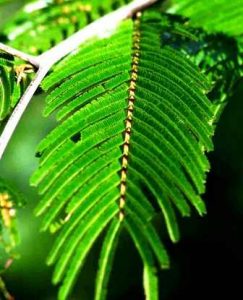
Newtonia buchananii. Photo: Bart Wursten. Source: Flora of Zimbabwe
On to Newtonia buchananii with its winged seeds, cylindrical flowers, 2-pinnate leaves with numerous small leaflets and, contrary to my statement in last month’s Tree Life, glands on the rhachis between each pinna. This is an Eastern Districts tree, normally a climax species, but occasionally behaving as a pioneer.
We later saw Newtonia hildebrandtii. This is easily separated from Newtonia buchananii because of its far fewer pinnae, it grows along lowveld rivers and unlike Newtonia hildebrandtii it is difficult to grow in the Botanic Gardens.
We next looked at the remarkable Entada pursaetha.
This is a very rare Zimbabwean species, having been recorded only once near the Haroni River. It is a climber and does very well in the Botanic Gardens.
The flowers are in spikes, the leaves 2-pinnate with approximately 2 pinnae, but the most remarkable feature is the pod. Sadly, none were to be found on this occasion, but they can attain 1.5 metres in length. Like other species of Entada the pods split transversely into segments, each segment containing a seed. Generally, it is a typical species of riverine forest along the Indian Ocean and the seeds may be found floating in the ocean.
Entada chrysostachys is another climber but the specimen in the Gardens was a leafless shrub with a single whip-like stem. This species is to be found along the Mazowe River. We later saw Entada abyssinica, which is a tree and occurs in high rainfall woodland, mainly in the Mutare area. On this specimen were the remains of one or two pods, showing clearly the transverse splitting and the remains of the oblong ‘hoop’ which is the edge of the pod and contains the segments.
Once again, our thanks go to Tom for a most interesting walk.
-Mark Hyde.
ANDY MACNAUGHTAN CHAIRMAN


